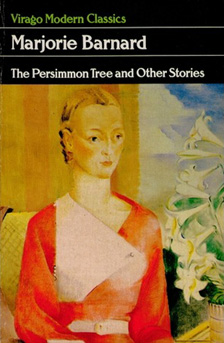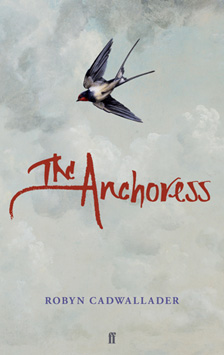Marjorie Barnard: ‘The Persimmon Tree’
by Robyn Cadwallader I have so many favourite stories! As I wander through them in my mind, the styles are so different, but each one has me excited me in some way. Sometimes it is perception, seeing beyond the familiar or the surface of things; sometimes it is the use of language; sometimes it is empathetic characterisation; sometimes it is the ability to take me beyond my circumscribed world. And nearly always, it is a story that makes me say, “Ah, so this is possible. Words, language, story can do this.”
I have so many favourite stories! As I wander through them in my mind, the styles are so different, but each one has me excited me in some way. Sometimes it is perception, seeing beyond the familiar or the surface of things; sometimes it is the use of language; sometimes it is empathetic characterisation; sometimes it is the ability to take me beyond my circumscribed world. And nearly always, it is a story that makes me say, “Ah, so this is possible. Words, language, story can do this.”
I love writing that takes risks, and I’m often drawn to bold and innovative use of language, but I also know that it is vital to know the traditions of my art. Quite a few years ago a jazz musician told me that, in order to be really good at his craft, knowing how to play around with rhythm, melody and harmony, he had recognised that first of all he must learn their foundations in classical music. With that in mind, the story I come back to as one that does so much with the short story form, and does it so well, is ‘The Persimmon Tree’ by the Australian writer Marjorie Barnard (1897–1987). For me, it something of a touchstone.
What I so admire about ‘The Persimmon Tree’ is its subtle revelation of the narrator’s state of mind and heart; very little happens, apparently, but so much is suggested. This is the short story as iceberg, the words and story making the reader aware of so much more that is unspoken, submerged beneath. The storyline is simple and told in first person: a woman recovering from illness takes a single-roomed flat where she can quietly recuperate. A story of tentative recovery and sadness, it begins with a statement of hope: “I saw the spring come once and I won’t forget it.” But the hope seems to be undercut by the next sentence: “Only once.” Those two sentences signal all that is to come, and by the end, we recognise what they mean: that she observes rather than feels new life, that it is a memory, not a present lived experience.
Most of all, I love the visual qualities of this story. The narrative, such as it is, progresses through several vivid scenes that could be paintings in themselves. The woman’s inner state is reflected in the flat she chooses, its colours neutral, the walls pale. It offers retreat and space: “It was a shell that fitted without touching me.” Her skin and her emotions are too fragile to engage with anyone or anything, and she speaks mostly of her observations. The tree outside her flat is budding, but instead of looking out, she has a painting removed from her lounge room wall so that she can watch the shadow the tree casts there. She wants life, not simply an artist’s impression of it, but the very sight of it would be too much vigour for her vulnerable state and she can only bear to watch its outline. The image is simple, beautiful, and it shows us so much.
Persimmons are autumn fruit, imported from another country, beautiful and yet out of place in this setting… The sight of the fruit evokes only memories of past sexuality, and the coming of new life makes her think only of its loss.”
However, into this pale, shadowy world comes a vivid sign of life, colour against the pale palette – three “deep, rich, golden-orange” persimmons “shaped like a young woman’s breasts” on the window ledge opposite. This single image changes the mood, shakes the woman from her quiescence, and seems to signal a shift in the story. But again, as with the opening sentences, the initial suggestion of life is undercut. Persimmons are autumn fruit, imported from another country, beautiful and yet out of place in this setting. The woman remembers the grove of persimmon trees from her childhood house, where “in the autumn they had blazed deep red”, making the rooms in the house look like they were burning, and she asks, “Why did I always think of autumn in springtime?” The sight of the fruit evokes only memories of past sexuality – the persimmons are like a young woman’s breasts; of a childhood home so different from her present; of trees most colourful as they lose their leaves, as if all that energy and life is past. The coming of new life makes her think only of its loss.
 The woman who lives in the flat opposite collects the ripened persimmons and some days later, places a bowl of bulbs to grow on the windowsill. As the narrator watches the green spears begin to shoot, she notices that the shadow of the tree on her wall is now complex with buds and leaves, but she doesn’t look at the tree itself: “I’d think about the buds, how pale and tender they were, but implacable… if man’s world were in ashes spring would still come”, and she feels a “frail, half-sweet melancholy”. Again, the coming of new life is separated from her, and there seems no certainty of recovery or, even more, a sense that physical recovery may not bring restoration.
The woman who lives in the flat opposite collects the ripened persimmons and some days later, places a bowl of bulbs to grow on the windowsill. As the narrator watches the green spears begin to shoot, she notices that the shadow of the tree on her wall is now complex with buds and leaves, but she doesn’t look at the tree itself: “I’d think about the buds, how pale and tender they were, but implacable… if man’s world were in ashes spring would still come”, and she feels a “frail, half-sweet melancholy”. Again, the coming of new life is separated from her, and there seems no certainty of recovery or, even more, a sense that physical recovery may not bring restoration.
The story ends with the still quiet scene of the woman opposite standing at her window, veiled by sheer curtains, and slowly allowing her gown to fall so that she stands naked, watching the budding tree. The narrator turns away: “The shadow of the burgeoning bough was on the white wall. I thought my heart would break.” The shadow of the naked woman and the shadow of the tree resonate with all that remains at a distance from the narrator. There is no resolution, and there is nothing more to say.
On occasions I wonder if the writing is too quiescent, almost, too still and too freighted with significance. But the story is too short, I think, to weigh us down, and its power is in its simplicity, the sense that nothing is happening, that everything is about distance and absence, yet so much is apparent, if not revealed. There is a cinematic quality to the writing, strong scenes that have stayed in my mind since the first time I read ‘The Persimmon Tree’. Each time I come back to it, I see something more. Given how short is Australia’s white literary history, it’s exciting to recognise the excellent work that is part of our foundation — especially that of a woman born in the 19th century.
 Robyn Cadwallader lives among vineyards outside Canberra and has published numerous poems, short stories and a non-fiction book based on her PhD thesis concerning attitudes to virginity and female agency in the Middle Ages. She lectured in English literature at Flinders University and has facilitated short courses on creative writing, journal writing and medieval culture. Her first novel, The Anchoress, about a 13th-century English merchant’s daughter who receives an unwelcome proposal of marriage after she has committed herself to a life of service to God, is published in the UK by Faber & Faber on 5 February. Read more.
Robyn Cadwallader lives among vineyards outside Canberra and has published numerous poems, short stories and a non-fiction book based on her PhD thesis concerning attitudes to virginity and female agency in the Middle Ages. She lectured in English literature at Flinders University and has facilitated short courses on creative writing, journal writing and medieval culture. Her first novel, The Anchoress, about a 13th-century English merchant’s daughter who receives an unwelcome proposal of marriage after she has committed herself to a life of service to God, is published in the UK by Faber & Faber on 5 February. Read more.
robyncadwallader.com
Author portrait © Che Chorley
Marjorie Barnard was a novelist, short-story writer, critic, historian and librarian who wrote five novels and a range of non-fiction books over two decades in collaboration with Flora Eldershaw (as M. Barnard Eldershaw). The Persimmon Tree and Other Stories was first published in 1943 by Clarendon Publishing, Sydney and reissued by Virago Modern Classics in 1985 and by CreateSpace in 2013. The title story also appears in The Penguin Book of Australian Short Stories, edited by Harry Heseltine (1976).

